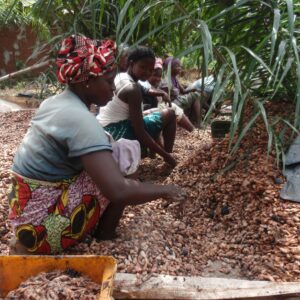Climate adaption horticulture and cocoa sector in Ghana

Climate adaption horticulture and cocoa sector in Ghana
Smart way of dealing with climate change
Climate change is having increasingly negative impacts on horticulture and cocoa farming in Ghana. Therefore, urgent measures within these sectors are needed to reverse this process or adapt to these changes. Measures that will contribute to climate change adaptation and mitigation are explored in a study conducted by Partners for Innovation for the Netherlands’ Embassy in Ghana and RVO
Climate change scenarios show that temperatures will continue to rise throughout the 21st century and that extreme high temperatures will become more frequent as well as extremes in dry and wet seasons. This all is causing growing seasons for the horti- and cocoa sector to shift.
This has implications for the quality and size of Ghana’s horticulture and cocoa crop yields, though sensitivity to rising temperatures and periods of drought varies by crop and region. The urgency to combat drought stress is greatest for tomato and cocoa crops; for onion and pineapple crops, periods with excess water poses a big problem. Yields are expected to fall and crop losses to rise for coconut and cocoa, among others, with negative socio-economic consequences.
Effect of horticulture and cocoa cultivation on climate
Conversely, horticulture and cocoa cultivation also affect the climate. This varies greatly by crop. Tomatoes are the most important crop in terms of volume produced. They emit the most greenhouse gas and use the most water, although data on this is scarce. Cocoa also causes significant greenhouse gas emissions, mainly due to methane emissions from the cocoa pods that are left in the fields after harvesting.
Measures to be taken
Turning the tide does not require reinventing the wheel. Adaptation and mitigation measures can be well aligned with ongoing climate actions and strategies. Ghana’s national horticultural strategy, for instance, focuses on irrigation and training: topics that are being taken up through a series of projects, including Dutch government-funded projects. These can be built on. For the cocoa sector, improving shade through agroforestry, stopping deforestation and reforestation, and reducing greenhouse gas emissions from decaying cocoa pods will be particularly effective.
How to move forward?
For the horticultural sector, knowledge exchange should be a priority, for instance through demonstration farms and agro-advisory services. The development and implementation of affordable drip irrigation systems would also provide a solution. The cocoa sector would particularly benefit from the productive use of residues, especially the pods of cocoa beans. Furthermore, agro-economic advice on climate-friendly, deforestation-free cocoa farming and digitalisation to support ‘climate smart’ horticulture and cocoa could help. For both sectors, afforestation and reforestation initiatives as part of agroforestry practices – combining crops with different types of trees – can provide multiple benefits including increased biodiversity and carbon sequestration, better water retention and reduced heat stress through shading.
More information
This project description is based on comprehensive summary of the final report of the study ‘Climate mitigation and adaptation assessment in Horti & Cocoa sectors in Ghana’ (2023-2024) conducted under the ‘Climate and Energy Response Facility’ (CERF) for the Embassy of the Kingdom of the Netherlands in Ghana and RVO.
Look at our related projects
Other
projects

Biomass potential in Côte d’Ivoire
We studied the potential of cashew, cassava, cocoa, palm oil, and rubber.

Climate impact cocoa pods
Farmers and environment Ivory Coast can benefit from better utilization, our study shows.

Useful application of cocoa residues
More yield and better quality thanks to biogas
Want to
know more?
Contact us!



